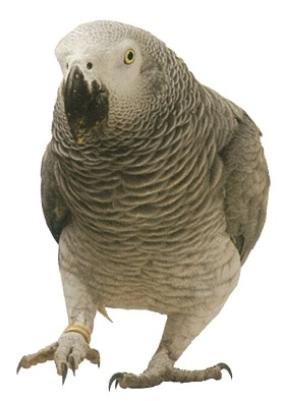Oxygen in fresh air is used to 'burn' the bird's fuel, which is the food it has broken down. This 'fuel' is used for bodily functions, such as keeping warm and powering the muscles for the bird's range of activities including flight. Flight is extremely demanding in terms of energy use. As a result, birds have evolved an elaborate breathing system which ensures oxygen is taken up at the elevated rates needed to support such levels of activity. The waste products of this activity are mainly carbon dioxide and water, and these are eliminated as the bird exhales with the same speed at which oxygen is used. In terms of effort, the difference between a bird walking and then flying is a bit like the difference between a car trundling around in first gear and then being driven at high speed in top gear.
In addition to their lungs, which are similar to ours, birds have a system of air-sacs throughout their bodies. By shunting air around these air-sacs at high speed, birds can deliver a constant supply of fresh air to the lungs. The air travels over the lungs in the same direction all the time, rather than just being sucked in and blown out as with our breathing. These refinements mean a bird's breathing abilities are 25 per cent more efficient than ours.
Parrots have a four-chambered heart similar to ours and the bird's blood circulatory system works at a high-speed level to match its highspeed breathing. Even while at rest a parrot's heart beats at about 140 times per minute; more than twice the rate of a human heart. When flying, this increases to around 900 beats per minute and this is quite normal for parrots. A grey's normal blood temperature is 40-41 °C (104-106°F) - much higher than is found in humans. All these adaptations allow a parrot's body to operate at a much higher rate than is found in mammals of a similar size and this is needed to ensure the birds can fly well without becoming exhausted.
In addition to their lungs, which are similar to ours, birds have a system of air-sacs throughout their bodies. By shunting air around these air-sacs at high speed, birds can deliver a constant supply of fresh air to the lungs. The air travels over the lungs in the same direction all the time, rather than just being sucked in and blown out as with our breathing. These refinements mean a bird's breathing abilities are 25 per cent more efficient than ours.
Parrots have a four-chambered heart similar to ours and the bird's blood circulatory system works at a high-speed level to match its highspeed breathing. Even while at rest a parrot's heart beats at about 140 times per minute; more than twice the rate of a human heart. When flying, this increases to around 900 beats per minute and this is quite normal for parrots. A grey's normal blood temperature is 40-41 °C (104-106°F) - much higher than is found in humans. All these adaptations allow a parrot's body to operate at a much higher rate than is found in mammals of a similar size and this is needed to ensure the birds can fly well without becoming exhausted.


A resting or walking grey uses little energy
compared to that used in flight. The initial take-off
and upward flight demand a sudden surge in energy.
compared to that used in flight. The initial take-off
and upward flight demand a sudden surge in energy.
Greys can make very rapid changes to
their heart rate. The heart can beat more than
six times faster than its resting rate
within a few seconds.
their heart rate. The heart can beat more than
six times faster than its resting rate
within a few seconds.

A grey's lungs are quite
small considering the size of the bird.
However, their efficiency is greatly improved by the air-sac breathing system which is unique to birds.
Some of the main air sacs of a parrot are shown above. Unlike mammals,
when a bird's breathing system is relaxed, air rushes in.
The bird has to force air out by actively constricting its chest cavity.
On relaxing the chest, more fresh air enters immediately.
However, their efficiency is greatly improved by the air-sac breathing system which is unique to birds.
Some of the main air sacs of a parrot are shown above. Unlike mammals,
when a bird's breathing system is relaxed, air rushes in.
The bird has to force air out by actively constricting its chest cavity.
On relaxing the chest, more fresh air enters immediately.